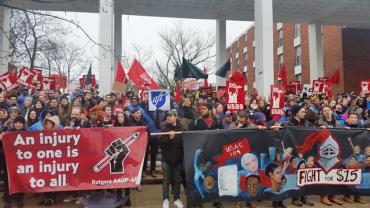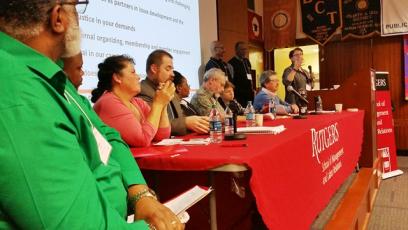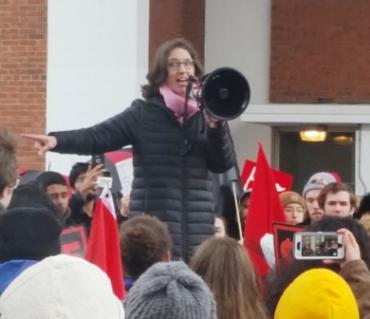Rooms were packed and rallies loud during the filled-to-capacity Bargaining for the Common Good in Higher Education Convening at Rutgers University in New Brunswick, N.J., Feb. 22-24. Hundreds of activists, including a wide array of AFT members, other unionists and community organizers, were eager to dive deep into finding ways their work can serve not just their members, but other people in their communities and the public good at large.
Bargaining for the common good—essentially expanding union focus beyond wages and benefits to address broader community issues—is occurring at a time of extreme challenge but also remarkable opportunity, said Joseph McCartin, executive director of Georgetown University's Kalmanovitz Initiative for Labor and the Working Poor. The American working landscape has been transformed by overreliance on a gig economy (including on adjunct faculty), exploitative employment practices facilitated by deregulation, underregulation that threatens workplace safety, and an assault on public sector unions, he said. On the other hand, the emergence of new initiatives of empowerment—including the movement for black lives, the Fight for $15, and the recent uprising among youth fighting for gun control—are reasons for hope. McCartin counts bargaining for the common good among these bright lights, and frames it as a way to "foster solidarity between unionized workers and the broader community." In higher education, he adds, it could "help transform educational institutions from crucibles of the economy of inequity into epicenters of democratic empowerment."
Stephen Lerner, also with the Kalmanovitz Initiative, described the moment as "tilting between barbarism and a real thirst for justice," and told participants, "What we do individually and collectively is more important than at any time in our lives."
Early successes
Bargaining for the common good has already had some success. The Saint Paul (Minn.) Federation of Teachers modeled it when members asked their neighbors what the community needed most in its public schools, and then folded those demands into its 2013 and 2015 contracts. The result was reduced class sizes; more school nurses, counselors, social workers and librarians; expanded family engagement programs; and mechanisms to address institutional racism.
"Our fundamental idea was that our contract should be the most powerful document to attract and retain the professional workforce that knows how to meet the needs of students in St. Paul," said Mary Cathryn Ricker, who was president of the SPFT at the time and is now the AFT's executive vice president. With a contract centered on students, the ways in which the union can contribute to the community are limitless, she said.
But Ricker also warned that bargaining for the common good requires that seeds be planted years before a contract is signed, and it has to be maintained and continued. "The campaign is never over," she said, a point echoed by others who agreed the bonds created with community are more lasting than any contract.
Other examples of successful common-good work include the California Faculty Association's "cultural taxation" contract provision. As described by the CFA's Cecil Canton, CFA faculty can be compensated for time spent mentoring "underserved, first generation, and/or underrepresented students," a task that disproportionately falls to faculty of color and affects their professional development. The provision values those contributions as part of their legitimate workload rather than as an extra burden that takes away from the "real" work of academia.
At the University of California, the union once focused on job security and was unconcerned about the university's growth initiatives, admitted Liz Perlman, executive director of the AFSCME employee local there. But when UC-Berkeley tried to expand into nearby Richmond, Calif., a primarily black and Latino community that would have been displaced by plans for a multibillion-dollar research campus, the union swung into action. When union members consulted Richmond residents, Perlman said, they learned how disruptive the construction would be; they then vigorously opposed the project, appealing to donors who eventually pulled their funding and defeated it.
It's about money and millionaires
These victories are hard-won and involve considerable knowledge and organizing savvy, another focus of the convening at Rutgers. Going after the financiers of universities can be key, as participants learned at a joint session with the United Students Against Sweatshops annual conference. "Wall Street has its tentacles over everything in the private and public sectors," said Saqib Bhatti, co-executive director of the Action Center on Race and the Economy. Powerful corporations are among the biggest lobbyists in Congress and state governments, pushing for tax cuts—which result in slashed funding for public higher education—as well as deregulation and privatization. Hedge funds swallow up university endowments and pensions, charging high fees despite relatively low returns, and investing money in everything from private prisons to fossil fuels and Puerto Rican debt. University board membership is heavily skewed toward financiers who frequently advantage their investments with favorable votes on university research, grants and hiring. "Universities have become just another vehicle for wealth extraction," said Bhatti.
These activities may seem removed from on-campus experience, but they affect everyone. At the University of Massachusetts in Boston, for example, parking fees have increased and plans are in place to build expensive, privatized lots; the fees are one more burden for low-income students driving to this commuter campus, and many skip classes as a result.
The Justice League
So, how to fight such behemoths? By coming together with like-minded groups—including students. "This feels like the Justice League," said one student, noting the power of the larger community as he described Rutgers One, a coalition of a dozen campus unions, student groups and community groups. "We represent the past, present and future of the labor movement," said another student, just before USAS and Bargaining for the Common Good participants marched outside the building for a rally with Fight for $15, the group advocating for a livable wage.
"We have to fight for our students and our communities," Rutgers professor Deepa Kumar told the cheering crowd, listing affordable healthcare, pay equity, job security and free higher education as essential to ensuring dignity for all. "The woman who cleans the building where I work cannot afford to take my class," she said. "That is a shame."
"We will stand united," said the AFT's Ricker at the rally. "We are here together. We are here for good."
Down to business
Back at the convening, participants gathered by cohort, drilling down to determine how to take the inspirational message of bargaining for the common good into their own locals back home. Ideas ranged from early steps, such as listing and contacting potential partner organizations and scheduling meetings with other unions on campus, negotiating to "ban the box" (the requirement that ex-felons identify themselves on college and job applications), and fighting changes to rent control that would threaten the availability of affordable housing for students and campus workers.
"How do we link to what other folks are doing? How do we center racial justice? Lots of folks have the words, but we don't have the actions yet," said conference organizer Marilyn Sneiderman, director of the Center for Innovation in Worker Organization at Rutgers' School of Management and Labor Relations and a member of Rutgers AAUP-AFT. The convening was designed to change that.
The AFT co-sponsored the convening, and participating members came from a number of affiliates, including AFT 2121 (San Francisco), the Chicago Teachers Union, Health Professionals and Allied Employees (New Jersey), the Illinois Federation of Teachers, University Professionals of Illinois, the Professional Staff Congress (City University of New York), Rutgers AAUP-AFT, Temple Association of University Professionals (Philadelphia), the Union of Rutgers Administrators, and United Academics of Philadelphia.
[Virginia Myers]



